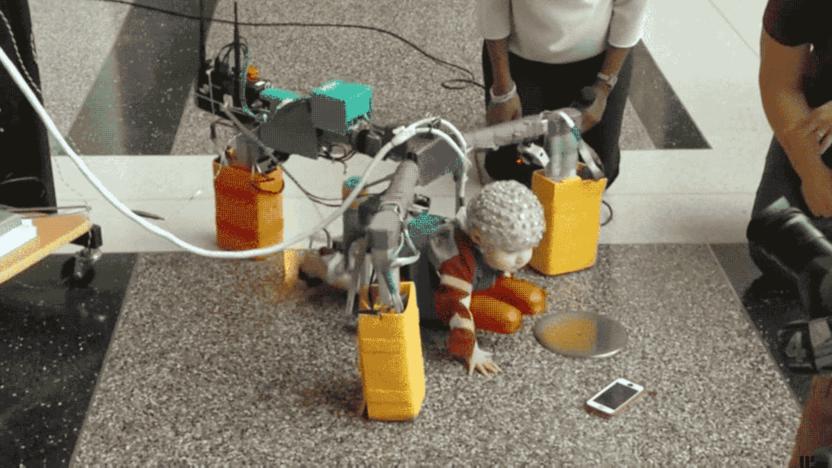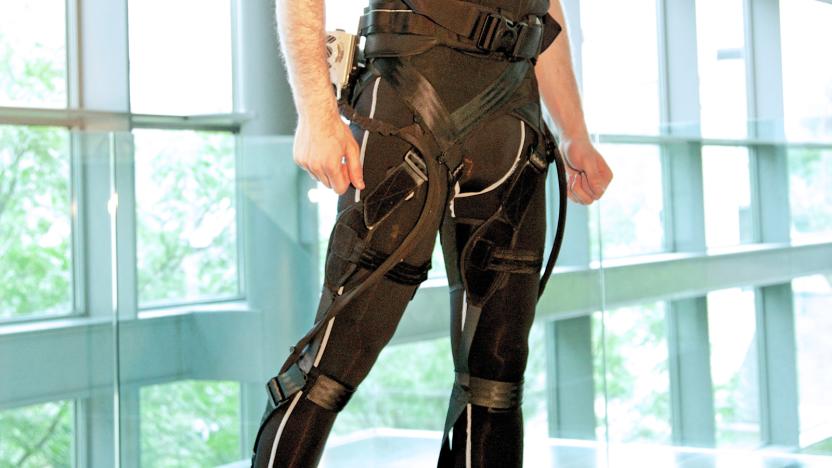RoboticExoskeleton
Latest

Robotic exoskeleton for babies can help prevent cerebral palsy
University of Oklahoma's robotic exoskeleton for babies does two things: (1) make the kiddos look like tiny Dr. Octopuses and (2) help prevent cerebral palsy. The motorized device has power steering that gives babies at risk of CP a little push needed to be able to move and crawl like their peers can. See, the condition can be caused brain damage, infections and injuries early in a person's life. To combat the disorder, therapy must start as early as possible -- unfortunately, it's not typically diagnosed until a child turns one year old.

Harvard engineers designed a 'soft wearable robot'
A team of engineers from Harvard University's Wyss Institute for Biologically Inspired Engineering have moved one step closer to a consumer version of a soft, assistive exosuit that could help patients with lower limb disabilities walk again. The Wyss Institute announced today that the university is collaborating with ReWalk Robotics to bring its wearable robotic suit to market.

RB3D develops Hercule robotic exoskeleton, boosts strength without P90X
Sure, some folks could use a little extra help maneuvering in order to complete daily chores. But what about help with all of that heavy lifting? The folks at RB3D in France have been working with the French Directorate General of Armaments (DGA), ESME Sudria and CES LIST to develop a robotic exoskeleton that will aid in doing just that. Hercule, the aforementioned cobot-esque (collaborative robot) prototype, doesn't require any special training or skills to use. A person needing extra strength to carry that crate of supplies just wears the device and goes about his or her business with the added support of the exosuit. This particular model is powered electrically and will last about 20km (about 12.5 miles) if movement is kept at a regular walking pace. Weight limits, you ask? The Hercule boasts a carrying capacity of 100kg (220lbs) -- more than HAL tech we've seen in aiding travelers in the past. Military and civil customers could get their hands on these as early as 2014, but for now, jump past the break for a look at one in action.

Paralyzed student uses robotic exoskeleton to walk at college graduation (video)
Austin Whitney hasn't been able to walk since a 2007 car crash left him paralyzed, but on Saturday the 22-year-old triumphantly strode across the stage to accept his degree from UC Berkeley. He had a little help, in the form of a specially crafted robotic exoskeleton developed by Berkeley engineering professor Homayoon Kazerooni. Kazerooni and his team designed the exoskeleton with lightness and affordability in mind, resisting the urge to load it up with expensive hardware and tethering the mechanized walker to a backpack that houses a computer and a rechargeable, eight-hour battery. As a result, the Austin walker won't enable the kind of acrobatic leaps that would make Lt. Rasczak proud, but its reduced mobility comes at a reduced cost of just $15,000. That's certainly not an impulse buy, though it's a welcomed alternative to other exoskeletons that retail for $100,000 or more. Walk past the break for a video of Whitney's momentous steps, along with a clip of Kazerooni describing his creation.

New Zealand paralympian buys first Rex Bionics exoskeleton, takes robot walking legs for a spin
Surely we weren't the only ones to wonder aloud who would be the first come up with $150,000 for a Rex Bionics robotic exoskeleton when the Auckland-based company introduced it last summer. Of course, no price seems too high for the ability to walk again, but that's still a lot scratch to get together -- and the space has been getting a lot more competitive as of late. The honor went to fellow Kiwi Dave MacCalman, a multiple medal-winning paralympian, who lost the use of his legs after sustaining a spinal cord injury while diving into a river. The 6-foot, 4-inch athlete took his first steps in over 30 years with the use of his newly-purchased robot legs -- and from the look on his face, he definitely got his New Zealand dollar's worth. If you need a quick refresher on exactly what this thing can do, check out the video after the break.

LOPES rehab robot gets bodies moving -- no relation to JLo (video)
That's LOPES (Lower-extremity Powered ExoSkeleton) -- not Lopez -- and while this rehab robot can get otherwise disinclined parties to move their butts, it doesn't resort to monotonous dance beats to do so. Researchers at the Netherlands' University of Twente began work on LOPES in 2001 to assess motor skills and teach stroke victims how to walk again. Ten years later, LOPES -- which looks like Forrest Gump's leg braces on steroids -- now sports eight degrees of freedom and automatically adjusts to fit the specific support needed per patient. LOPES' overlords are working on a more compact and user friendly iteration, and expect a market-ready version to be available by mid-2012. In the meantime, LOPES has been enlisted in a larger EU project called Mindwalker, testing advanced control algorithms "to be used in autonomous exoskeletons." Video of the future real-life RoboCop after the jump. [Thanks, Mike]

Rex, the robotic exoskeleton, aims to make wheelchairs obsolete
New Zealand isn't exactly known for being a hotbed of tech innovation, but this set of bionic legs might just realign that perception a little bit. The product of seven years of development work, the Rex exoskeleton is capable of supporting the full weight of a person -- making it suitable for paraplegics -- and moving him or her around in a familiar bipedal fashion. It's operated using a joystick and control pad and is simple enough for handicapped users to self-transfer in and out of. The best news, perhaps, is that it's about to go on sale in its home country this year, with an international launch following in 2011. The worst news? Probably the $150,000 (US) initial asking price, but then we'd hardly say we're qualified to judge the value of being able to walk again. Video and full press release after the break. [Thanks, Kurt and Simon]

New robotic exoskeleton aims to help farmers combat age, mutant plants
Well, it looks like there's been yet another development in the exoskeleton arms race between the US and Japan, with this latest entrant from the Tokyo University of Agriculture and Technology promising to help farmers and gardeners deal better with old age and increasingly unwieldy crops. This one weighs in at a somewhat hefty 55 pounds but, like most such exoskeletons, it's able to offload most of its own weight thanks to the use of eight motors and 16 sensors, which also, of course, help to give its wearer some super-strength. Better still, the researchers say the suit could be available in as soon as three years, and cost somewhere between $5,000 and $10,000.[Via Engadget German]

Robotic exoskeleton takes over for your lazy muscles
Finally all this research into artificial limbs and human strength augmentation -- as if we'd want to lift stuff -- has resulted in a robotic exoskeleton that doesn't help your muscles do more, but instead allows them to do less. It was designed by researchers at University of Michigan, and is currently being tested on healthy subjects. The ankle exoskeleton is fitted with electrodes which are attached to the wearer's leg muscles and allow the robotics to anticipate muscle movement and perform the action itself. At first a healthy user's gait is disrupted by this extra boost, but after about 30 minutes the person learns to use their own muscles less and have the exoskeleton do most of the walking. We figure similar tests done on a blogger would result in total adaptation in about 7 seconds. Of course, the plan down the road is to use these pneumatic artificial muscles to sense the weaker electrical signals being sent by certain people with spinal injuries or neurological disorders to allow them to move with full strength or to rehabilitate old muscle movements, but that testing has yet to begin, and for now the achievements of this project are purely for the lazy at heart.






